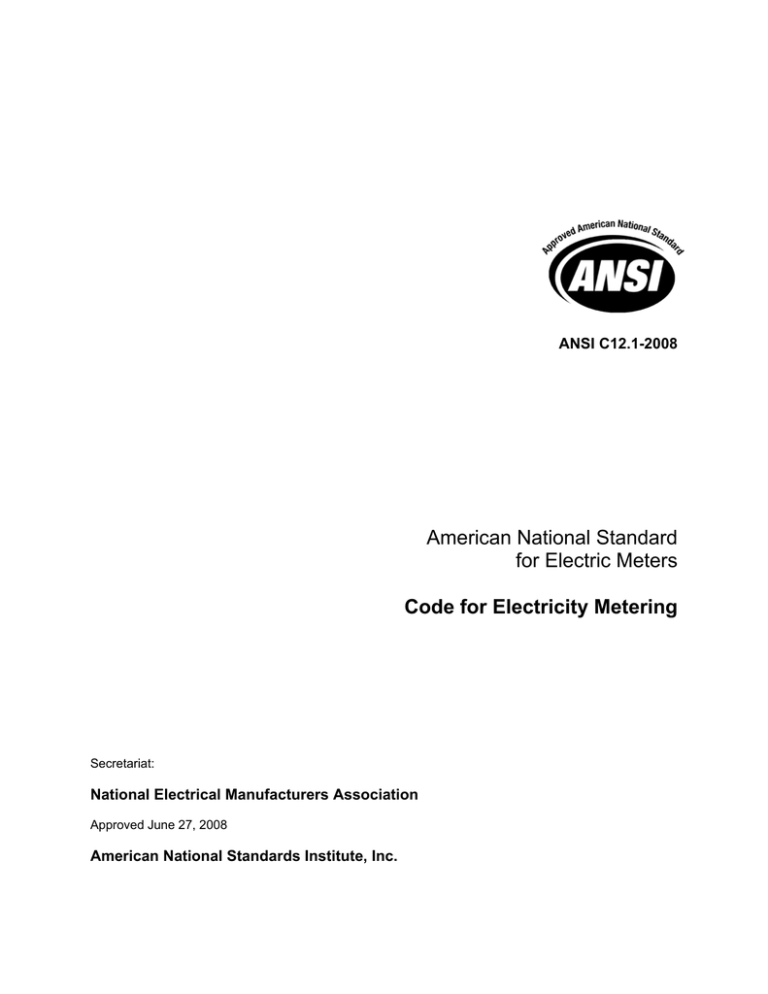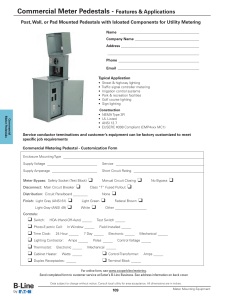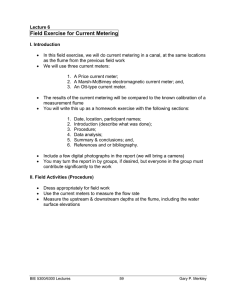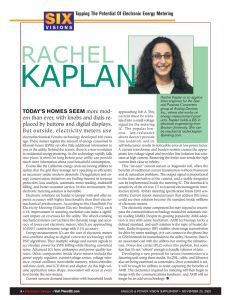
ANSI C12.1-2008
American National Standard
for Electric Meters
Code for Electricity Metering
Secretariat:
National Electrical Manufacturers Association
Approved June 27, 2008
American National Standards Institute, Inc.
ANSI C12.1-2008
NOTICE AND DISCLAIMER
The information in this publication was considered technically sound by the consensus of persons
engaged in the development and approval of the document at the time it was developed. Consensus
does not necessarily mean that there is unanimous agreement among every person participating in the
development of this document.
NEMA standards and guideline publications, of which the document contained herein is one, are
developed through a voluntary consensus standards development process. This process brings together
volunteers and/or seeks out the views of persons who have an interest in the topic covered by this
publication. While NEMA administers the process and establishes rules to promote fairness in the
development of consensus, it does not write the document and it does not independently test, evaluate,
or verify the accuracy or completeness of any information or the soundness of any judgments contained
in its standards and guideline publications.
NEMA disclaims liability for any personal injury, property, or other damages of any nature whatsoever,
whether special, indirect, consequential, or compensatory, directly or indirectly resulting from the
publication, use of, application, or reliance on this document. NEMA disclaims and makes no guaranty or
warranty, express or implied, as to the accuracy or completeness of any information published herein,
and disclaims and makes no warranty that the information in this document will fulfill any of your particular
purposes or needs. NEMA does not undertake to guarantee the performance of any individual
manufacturer or seller’s products or services by virtue of this standard or guide.
In publishing and making this document available, NEMA is not undertaking to render professional or
other services for or on behalf of any person or entity, nor is NEMA undertaking to perform any duty owed
by any person or entity to someone else. Anyone using this document should rely on his or her own
independent judgment or, as appropriate, seek the advice of a competent professional in determining the
exercise of reasonable care in any given circumstances. Information and other standards on the topic
covered by this publication may be available from other sources, which the user may wish to consult for
additional views or information not covered by this publication.
NEMA has no power, nor does it undertake to police or enforce compliance with the contents of this
document. NEMA does not certify, test, or inspect products, designs, or installations for safety or health
purposes. Any certification or other statement of compliance with any health or safety-related information
in this document shall not be attributable to NEMA and is solely the responsibility of the certifier or maker
of the statement.
ANSI C12.1-2008
AMERICAN
NATIONAL
STANDARD
Approval of an American National Standard requires verification by
ANSI that the requirements for due process, consensus, and other
criteria for approval have been met by the standards developer.
Consensus is established when, in the judgment of the ANSI Board of
Standards Review, substantial agreement has been reached by directly
and materially affected interests. Substantial agreement means much
more than a simple majority, but not necessarily unanimity. Consensus
requires that all views and objections be considered, and that a
concerted effort be made toward their resolution.
The use of American National Standards is completely voluntary; their
existence does not in any respect preclude anyone, whether he has
approved the standards or not, from manufacturing, marketing,
purchasing, or using products, processes, or procedures not
conforming to the standards.
The American National Standards Institute does not develop standards
and will in no circumstances give an interpretation of any American
National Standard. Moreover, no person shall have the right or
authority to issue an interpretation of an American National Standard in
the name of the American National Standards Institute. Requests for
interpretations should be addressed to the secretariat or sponsor
whose name appears on the title page of this standard.
Caution Notice: This American National Standard may be revised or
withdrawn at any time. The procedures of the American National
Standards Institute require that action be taken periodically to reaffirm,
revise, or withdraw this standard. Purchasers of American National
Standards may receive current information on all standards by calling or
writing the American National Standards Institute.
Published by
National Electrical Manufacturers Association
1300 North 17th Street, Rosslyn, VA 22209
© Copyright 2008 by National Electrical Manufacturers Association
All rights reserved including translation into other languages, reserved under the Universal Copyright
Convention, the Berne Convention for the Protection of Literary and Artistic Works, and the International
and Pan American Copyright Conventions.
No part of this publication may be reproduced in any form, in an electronic retrieval system or otherwise, without the
prior written permission of the publisher.
Printed in the United States of America
i
ANSI C12.1-2008
This page intentionally left blank.
ii
ANSI C12.1-2008
TABLE OF CONTENTS
Foreword .........................................................................................................................................vii
1
Scope and references...................................................................................................................... 1
1.2
References.......................................................................................................................... 1
2
Definitions ........................................................................................................................................ 3
3
Standards and standardizing equipment ....................................................................................... 10
3.1
Scope ................................................................................................................................ 10
3.2
Final authority.................................................................................................................... 10
3.3
Traceability paths to NIST................................................................................................. 10
3.3.1 Direct transfer ...................................................................................................... 10
3.4
Meter laboratory ................................................................................................................ 11
3.4.1 Laboratory conditions........................................................................................... 11
3.4.2 Reference temperature and humidity .................................................................. 12
3.4.3 Laboratory power sources ................................................................................... 12
3.5
Meter shop ........................................................................................................................ 12
3.6
Laboratory standards ........................................................................................................ 12
3.6.1 Basic reference standards ................................................................................... 12
3.6.2 Transport standards............................................................................................. 12
3.7
Periodic verification of reference standards ..................................................................... 12
3.8
Portable/field/working standard watthour meters ............................................................. 12
3.9
Performance records ........................................................................................................ 12
3.10
Performance requirements for standard watthour meters ................................................ 13
3.10.1 General test conditions ........................................................................................ 13
3.10.2 Accuracy tests for portable and reference standards .......................................... 13
4
Acceptable performance of new types of electricity metering devices and associated
equipment ...................................................................................................................................... 15
4.1
General ............................................................................................................................. 15
4.1.1 Acceptable metering devices............................................................................... 15
4.1.2 Adequacy of testing laboratory ............................................................................ 15
4.1.3 Retesting of new meter type ................................................................................ 15
4.1.4 Test documentation ............................................................................................. 15
4.1.5 Test device........................................................................................................... 15
4.1.6 Tests performed in series .................................................................................... 15
4.1.7 Handling of failed device...................................................................................... 15
4.1.8 Restart testing ...................................................................................................... 15
4.1.9 Reporting of test metering devices ...................................................................... 16
4.2
Types of metering devices ................................................................................................ 16
4.2.1 Basic type............................................................................................................. 16
4.2.2 Variations within the basic type ........................................................................... 16
4.2.3 Type designation.................................................................................................. 16
4.2.4 Acceptance of basic types in whole or part ......................................................... 16
4.2.5 Minor variations.................................................................................................... 16
4.2.6 Special types........................................................................................................ 16
4.3
Specifications for design and construction ....................................................................... 16
4.3.1 Sealing ................................................................................................................ 16
4.3.2 Enclosures ........................................................................................................... 16
4.3.3 Terminals and markings....................................................................................... 17
4.3.4 Construction and workmanship ........................................................................... 17
4.3.5 Provision for adjustment ...................................................................................... 17
4.4
Selection of metering devices for approval tests .............................................................. 17
iii
ANSI C12.1-2008
4.5
4.6
4.7
4.4.1 Samples to be representative of the basic type................................................... 17
4.4.2 Number to be tested ............................................................................................ 17
Conditions of test .............................................................................................................. 17
4.5.1 Tests to be applied............................................................................................... 17
4.5.2 Configuration........................................................................................................ 17
4.5.3 Metering devices for special services .................................................................. 18
4.5.4
Metering devices of non-standard classes ......................................................... 18
4.5.5 Metering devices with wide voltage range ........................................................... 18
Rules governing the acceptance of types......................................................................... 18
4.6.1 Tolerances ........................................................................................................... 18
4.6.2 Determination of Failure and Rejection ............................................................... 18
Performance requirements ............................................................................................... 19
4.7.1 Test conditions..................................................................................................... 19
4.7.2 Accuracy Tests—Internal Influences ................................................................... 21
4.7.3 Accuracy tests – external influences performance verification............................ 36
5
Standards for in-service performance............................................................................................ 54
5.1
Watthour meters and electronic registers ......................................................................... 54
5.1.1 Purpose................................................................................................................ 54
5.1.2 Accuracy requirements ........................................................................................ 54
5.1.3 Tests ................................................................................................................ 54
5.1.4 Performance tests................................................................................................ 55
5.1.5 Determination of average percentage registration .............................................. 56
5.2
Demand registers and pulse recorders ............................................................................ 57
5.2.1 Accuracy requirements ........................................................................................ 57
5.3
Instrument transformers (magnetic).................................................................................. 57
5.3.1 Pre-installation tests, (section 5. shall apply) ...................................................... 57
5.3.2 Instrument transformers removed from service................................................... 57
5.3.3 Performance tests................................................................................................ 58
5.4
Coupling-capacitor voltage transformers .......................................................................... 58
5.4.1 Performance tests................................................................................................ 58
6
Auxiliary pulse devices for electricity metering .............................................................................. 59
6.1
General ............................................................................................................................. 59
6.1.1 Information to be shown on pulse initiator ........................................................... 59
6.1.2 Information to be shown on pulse amplifier or relay ............................................ 59
6.1.3 Information to be shown on pulse totalizers ........................................................ 59
6.2
Tests to be applied............................................................................................................ 59
6.3
Performance requirements ............................................................................................... 59
6.3.1 Test conditions..................................................................................................... 59
6.3.2 Initial conditions ................................................................................................... 60
6.3.3 Mechanical load ................................................................................................... 60
6.3.4 Insulation.............................................................................................................. 60
6.3.5 Performance test.................................................................................................. 60
6.3.6 Sunlight interference test – pulse devices containing optical sensors ............... 61
APPENDICES
A ..................................................................................................................................................... 64
B ..................................................................................................................................................... 74
C..................................................................................................................................................... 93
D..................................................................................................................................................... 95
E ..................................................................................................................................................... 96
F ..................................................................................................................................................... 97
iv
ANSI C12.1-2008
TABLES
1
2
3
4
5
6
7
8
9
10
11
12
13
14
15
16
17
18
19
20
21
22
23
24
25
26
27
28
29
30
Portable and Reference Standards Percent Errors ....................................................................... 14
Table of Failures Based on the Number of Metering Devices Tested........................................... 19
List of Tests.................................................................................................................................... 20
Starting Load Test.......................................................................................................................... 21
Load Performance Test ................................................................................................................. 21
Effect of Variation of Power Factor for Single-Element Meters ..................................................... 22
Effect of Power Factor for Two-Element Meters:........................................................................... 22
Effect of Variation of Power Factor for Two-Element Three-Phase Four-Wire Wye Meters ......... 23
Effect of Variation of Power Factor for Three-Element Three-Phase Four-Wire Wye Meters .......... 23
Effect of Variation of Voltage ......................................................................................................... 24
Effect of Variation of Voltage on Solid-State Auxiliary Devices ..................................................... 24
Effects of Variation of Frequency................................................................................................... 25
Equality of Current Circuits in the Three-Wire Element for Single-Element Meters ...................... 25
Equality of Current Circuits in the Three-Wire Element for Multi-Element .................................... 26
Equality of Current Circuits between Elements for Multi-Element Meters..................................... 26
Temperature-Rise Test Specifications........................................................................................... 27
Effect of Internal Heating ............................................................................................................... 32
Effect of Tilt .................................................................................................................................... 33
Test for Independence of Elements in Two-Element Meters......................................................... 35
Test for Independence of Elements in Three-Element Meters ...................................................... 36
Effect of External Magnetic Field ................................................................................................... 38
Effect of Variation of Ambient Temperature................................................................................... 39
Effect of Variation of Temperature on Solid-State Auxiliary Devices............................................. 40
Effect of Temporary Overloads on Accuracy ................................................................................. 40
Effect of Current Surge in Ground Conductor................................................................................ 41
Test Modes, Voltage, and Application for Each External Connection Group—Oscillatory
Test ................................................................................................................................................ 44
Variable Interval Plan ..................................................................................................................... 56
Performance Test—Pulse Devices................................................................................................ 60
Portable Standard Watthour Meter ................................................................................................. 90
Reference Standard Watthour Meters ........................................................................................... 92
FIGURES
1
2
3
4
5
6
7
8
9
10
11
B.1
Dimensions for jumper bars of simulated meter temperature-rise test for single-phase
and polyphase meters (maximum rating 100 A) ............................................................................ 29
Dimensions for jumper bars of simulated meter temperature-rise test for single-phase
and polyphase meters (maximum rating 101 – 200 A rating)........................................................ 30
Dimensions for jumper bars of simulated meter temperature-rise test for single-phase
and polyphase meters (maximum rating 201 – 320 A rating)........................................................ 31
Electrical Fast Transient/Burst Test # 25....................................................................................... 42
Electrical Fast Transient/Burst Test # 25....................................................................................... 43
Typical test layout for radiated susceptibility—Test 26 and radiated and conducted
emissions—Test 27 ....................................................................................................................... 46
Typical wiring detail for self contained meters for radiated susceptibility —Test 26 and
radiated and conducted emissions —Test 27 ............................................................................... 47
Typical wiring detail for transformer rated meters for radiated susceptibility —Test 26 and
radiated and conducted emissions —Test 27 ............................................................................... 48
Typical GTEM test layout for Radiated Susceptibility Test............................................................ 49
Sunlight Interference Test.............................................................................................................. 62
Variable Angles Sunlight Interference Test ................................................................................... 63
Traceability path diagram............................................................................................................... 76
v
ANSI C12.1-2008
This page intentionally left blank.
vi
ANSI C12.1-2008
FOREWORD (This Foreword is not part of American National Standard
C12.1-2008)
This version of C12.1 has been modified in several areas in an effort to respond to a changing industry
and to improve the clarity of some of the tests. The changes, while not extensive, aim to improve the
consistency of test procedures and improve the quality of the metering products. This standard continues
to form the basic requirement for all kilowatthour metering instruments – both electronic and
electromechanical. Another standard in this series, ANSI C12.20, provides different test tolerances and a
few different tests that are required for higher accuracy metering devices.
Most of the meter specifications have been retained from the previous edition. Comments about the
significant changes follow. To help insure that new electronic equipment is as dependable as possible, an
oscillatory surge withstand test was added. Also, the requirement when retesting a new meter type was
made more restrictive. Minor changes to the temperature rise test were made to make testing more
uniform. Supplementary information was added to the equality of current circuits test, the electrostatic
discharge test, and the relative humidity test to clarify the testing process. For several of the tests specific
details for successful passing criteria have been included. References to external documents were
updated.
The Secretariat of the Accredited Standards Committee on Electricity Metering, C12, is held by the National
Electrical Manufacturers Association (NEMA) and the National Institute of Standards and Technology. At the
time this standard was processed and approved, the C12 Committee had the following members:
Tom Nelson, Chairman
Paul Orr, Secretary
Organization Represented
Center for Neighborhood Technology
Name of Representative
Lawrence Kotewa
Electric Light & Power
Lauren Pananen
John McEvoy
Tim Morgan
D. Young Nguyen
Elster Electricity, LLC
Scott Weikel
EnerNex Corporation
Aaron Snyder
Future DOS R&D Inc.
Avygdor Moise
General Electric, Energy
Curt Crittenden
Institute of Electrical and Electronics Engineers
Richard Tucker
Herman Millican
Itron, Inc.
Brent Cain
Landis+Gyr, Inc
John Voisine
Measurement Canada (Liaison No Vote)
Vuong Nguyen
vii
ANSI C12.1-2008
National Institute of Standards And Technology
Tom Nelson
Public Service Electric & Gas
David Ellis
Schweitzer Engineering Labs
Bob Hughes
Underwriters Laboratory
Ron Breschini
The following members of the C12.1 Committee were actively involved in the revision of this standard:
S. Weikel, Chairman
M. Anderson
N. Balko
L. Barto
B. Cain
R. Collins
B. Cook
C. Crittenden
J. DeMars
L. Durante
D. Ellis
T. Everidge
C. Gomez
W. Hardy
Bob Hughes
Brent Hughes
B. Kingham
L. Kotewa
T. Lawton
R. Lokys
E. Malemezian
G. Mayfield
J. McEvoy
H. Millican
A. Moise
T. Morgan
T. Nelson
D. Nguyen
V. Nguyen
D. Nordell
L. Pananen
C. Partridge
A. Rashid
A. Snyder
D. Tandon
A. Thompson
J. Thurber
J. Voisine
S. Weikel
J. West
In addition, the following comprised the Editorial Committee for the current Revision of C12.1:
L. Barto
E. Malemezian
P. Orr
A. Snyder
S. Weikel
viii
ANSI C12.1-2008
AMERICAN NATIONAL STANDARD
ANSI C12.1- 2008
Code For Electricity Metering
1
Scope and references
This Code establishes acceptable performance criteria for new types of ac watthour meters, demand
meters, demand registers, pulse devices, and auxiliary devices. It describes acceptable in-service
performance levels for meters and devices used in revenue metering. It also includes information on related
subjects, such as recommended measurement standards, installation requirements, test methods, and test
schedules. This Code for Electricity Metering is designed as a reference for those concerned with the art of
electricity metering, such as utilities, manufacturers, and regulatory bodies.
1.2
References
The following publications shall be used in conjunction with this standard. When they are superseded by an
approved revision, the revision shall apply:
ANSI/IEEE C63.4-2003, Methods of Measurement of Radio-Noise Emissions From Low-Voltage Electrical
and Electronic Equipment in the Range of 9 kHz to 40 GHz
ASQ Z1.4-2003, Sampling Procedures and Tables for Inspection by Attributes
ASQ Z1.9-2003, Sampling Procedures and Tables for Inspection by Variables for Percent Nonconforming
ASTM B117-2003, Standard Practice for Operating Salt Spray (Fog) Apparatus
ASTM G155 2005, Standard Practice for Operating Xenon Arc Light Apparatus for Exposure of NonMetallic Materials
Code of Federal Regulations (Telecommunication) CFR 47, Part 15—Radio Frequency Devices, Subparts
A—General and B—Unintentional Radiators
Chapter 13 “The Customers’ Premises, Service and Installations”, Handbook for Electricity Metering, 10th
Edition, Washington, D.C.: Edison Electric Institute, 2002
IEEE 1-2000, IEEE Recommended Practice: General Principles for Temperature Limits in the Rating of
Electric Equipment and for the Evaluation of Electrical Insulation
IEEE Std 100-2000, The Authoritative Dictionary of IEEE Standards Terms
IEEE C37.90.1-2002, IEEE Standard Surge Withstand Capability (SWC) Tests for Protective Relays and
Relay Systems Associated with Electric Power Apparatus
IEEE C57.13-1993, IEEE Standard Requirements for Instrument Transformers
IEEE C62.41.1-2002, IEEE Guide on the Surge Environment in Low-Voltage (1000 V and less) AC Power
Circuits
IEEE C62.41.2-2002, IEEE Recommended Practice on Characterization of Surges in Low-Voltage (1000 V
and less) AC Power Circuits
IEC 60068-2-6 (1995), Environmental Testing - Part 2: Tests, Test Fc: Vibration (Sinusoidal)
1





